A-Z of Medicinal Herbs
and How to Use Them
Medicinal
Herbs have
healing
properties that can be just as effective as over-the-counter pills and
potions, and costs you a fraction of the price. The best thing about
using herbs as part of your healing process is that you don't get the
side-effects that you get with modern medicine. I have been using herbs
for more than 3 decades to treat myself when I am ill and this is
always my first choice when ill.
Although I am a firm believer in herbal medicine, I am also aware that there are times when you need to seek the advice of an allopathic physician, and so I am not beating a drum here, but showing you that there is definitely help at hand, often in herbs that others might concern weeds, such as the common dandelion, that in fact is one of the most useful little herbs around.
Dandelions have been used to lower blood pressure, helps prevent some types of breast cancer, can help with acne, arthritis, constipation, eczema, and lowering high cholesterol.
So next time you are pulling those dandelions out of your garden cursing their existence, be grateful that they are there and think twice about their use and how your health will benefit from using them, rather than just throwing them away.
Drying is best in the shade where air circulation is good, either laid on racks or hung up in bunches.
Once the herbs are dry these can be stripped from the stalks, placed in brown paper bags and used when needed.
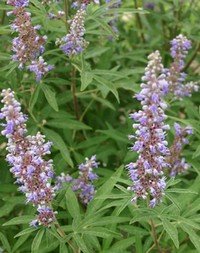 The berries were known as
"Monk's Pepper" as it was used in the food in
monasteries to reduce the libido in monks, although it is said to have
the opposite effect on women.
The berries were known as
"Monk's Pepper" as it was used in the food in
monasteries to reduce the libido in monks, although it is said to have
the opposite effect on women.
Origin: Native to the Mediterranean Area Grows: In well-drained soil in full sun. Grows to 15 feet, and spreads from 6-25 feet with pale, lilac flowers in early autumn.
Parts to Use: Harvest the berries when ripe in late autumn.
Uses: Mainly for gynaecological problems; irregular periods, acne and migraines related to the menstrual cycle. Also used for PMS and to regulate the hormones.
As a Tincture: Use 5 drops (1/2 teaspoon) in a little water 3 times a day. This is a powerful herb and should be used with caution. Start with a small dose to start off with. Don't use if you are pregnant.
 Parts to Use: Above
ground
parts, after flowering in the summer. Harvest
the leaves and flowers and dry for making tea.
Parts to Use: Above
ground
parts, after flowering in the summer. Harvest
the leaves and flowers and dry for making tea.
Uses: Excellent wound herb. Used to stop bleeding and to relieve pain. Tightens and tones body tissues.
As a Tincture: Effective against vaginal infections and cystitis, asthma, anxiety and stress, tapeworm, chronic diarrhea, dysentery.
Strip off the fresh flowers and leaves of the plants on a sunny day, pack into a glass jar, cover with brandy or vodka. Tighten lid and place in dark cupboard for 6 weeks, shaking every few days. After 6 weeks strain and label. Use 3-5 drops in a little water 3 times a day. For chronic situations, use 1/2 teaspoon in water, 3 times a day.
As a Tea: It can be used to bathe the eyes for conjunctivitis or as a gargle for sore throats or bad gums. Take 1-2 teaspoons dried leaves and flowers and pour over 1 cup of boiling water. Steep for 15 minutes and then drink up to 3 cups a day.
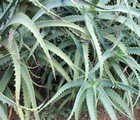 Grows:
In
sandy, well drained soil in a sunny place. As an aloe it needs little
water or care.
Grows:
In
sandy, well drained soil in a sunny place. As an aloe it needs little
water or care.
Parts to Use: The fleshy leaves and the gel inside. It can be harvested any time during the year.
Uses: Excellent for burns, insect bites, skin ulcers, wounds, nappy rash, eczema, ringworm, shingles and constipation.
Topical: Most of the time aloe vera gel is used directly on the skin. It needs little preparation to get the results. Just break off a little of the leaf, spilt it open and scrap out the soft inside, and place on the skin like a poultice.
As a Tincture: Pulp the leaves in a food processor. Place in jar and cover with brandy or vodka and process in the usual way. Take 1 teaspoon in some water, 3 times a day to treat a sluggish digestion and constipation.
Aloe Vera also makes an excellent chicken food.
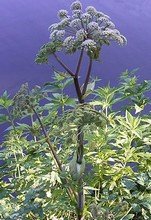 Picture
courtesy of Teun Spaans
Picture
courtesy of Teun Spaans
Origin: Native Northern Europe
Grows: This is a perennial that grows in moist soil in shady areas. Grows up to 8 feet in height and spreads to 4 feet. Harvest the leaves and stems in early summer, year old roots in autumn, seeds as they ripen.
Parts to Use: Leaves, roots, seeds for the essential oils
Uses: For arthritis, rheumatism, flatulance, poor circulation, bronchitis, coughs, sluggish digestion
As a Tincture:Use 1/4-1/2 teaspoon in a little water 3 times a day.
As a Tea: Take 1 teaspoons dried leaves and pour over 1 cup of boiling water. Steep for 15 minutes and then drink up to 3 cups a day. Use for indigestion.
As a Massage Oil: Extract the oil from the seeds and spread on chest for coughs and bronchial troubles.
As a Decoction: Simmer 1/2 oz of root in 1 pint of water. Use for arthritis and rheumatism, poor circulation, sluggish digestion and to warm up the body.
Caution: Don't use as a tea or a tincture if you are pregnant or if you are a diabetic.
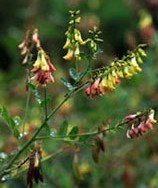 Origin:
Native to Asia
Origin:
Native to Asia
Grows: Grows in well-drained soil in full sun. Grows in a bush 3 feet high, 1 foot wide. To harvest, dig up the roots of 4 year old plants in autumn.
Parts to Use: Roots
Uses: For excess sweating, chronic fatigue, boosting the immune system and used with other herbs such as ginseng.
As a Tincture: Use 1/2 teaspoon in some water as a general tonic, to boost the immune system and for chronic fatigue.
Caution: Don't take if you are on blood-thinning tablets.
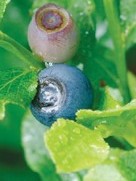 Seen as a superfood as it has antioxidant
properties.
Seen as a superfood as it has antioxidant
properties.
Origin: Europe and Asia
Grows: Loves very acidic soils that are moist. Likes partial shade, although will tolerate some sun. A small bush that grows 2 feet high and 2 feet wide. Harvest the leaves in spring and the berries in late summer.
Parts to Use: Berries and Leaves. Berries can be made into jams, pies, syrups, wine and liqueurs.
Uses: Excellent for improving eyesight especially if used in combination with ginkgo, including macular degeneration and glaucoma. It strengthens veins and capillaries, so good for those suffering from varicose veins. Regulates high blood sugar and urinary infections. Dried berries can be used for diarrhea. Fresh berries can be used for constipation.
As a Tea: For mouth ulcers, urinary infections, bed wetting, reducing high sugar levels, treating late-onset of diabetes.Use 1 teaspoon of dried leaves to 1 cup of boiling water. Steep for 10 minutes.
Caution: Do not use the leaves in tea for more than 3 weeks at a time.
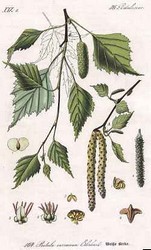 Origin:
Eurasia and the Sweet Birch native to eastern North America.
Origin:
Eurasia and the Sweet Birch native to eastern North America.
Grows: Like moist, damp, forested areas. Harvest the sap in the spring, before the buds and leaves appear.
Parts to Use: Bark, leaves and sap
Uses:
1) As a Sap: Birch sap is used for kidney stones, skin conditions and rheumatism. Drink in spring as a tonic and for a good detox. Tap the tree by drilling a small hole into the trunk with a tube leading into a bottle tied to the tree. Collect the sap for no longer than a week and plug the hole afterwards.
2) As a Tea: Using the spring buds and leaves for gout, urinary infections, cystitis, water retention. When cold it can be used directly on skin disorders and eczema. Leaves can be used fresh or dry. Use 5 leaves per cup of boiling water.
3) As an Oil: Steep birch leaves in olive oil and use as a massage oil for cellulite. Birch oil is used in commercial cellulite products.
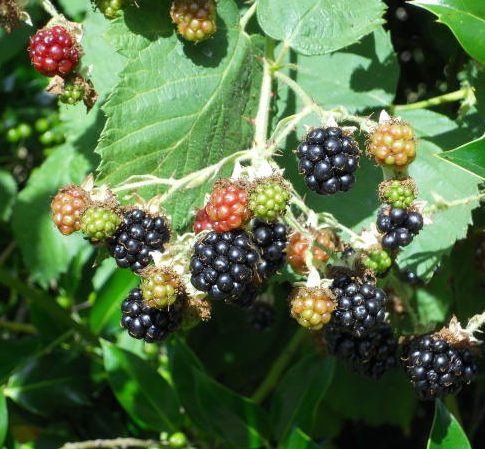 Origin: Europe
but also found in Australia, New Zealand and North America
Origin: Europe
but also found in Australia, New Zealand and North America
Grows: Wild in hedges in the countryside. Harvest the leaves in summer and the berries when ripe.
Parts to Use: Berries and Leaves.
Uses: 1) The berries are used extensively in country wines, jams, jellies, pies and syrups.
2) As a Poultice: Crushed blackberry leaves can be used for boils and small cuts and scratches on the skin. Ideal when you go blackberry picking!
3) As a Tea: The leaves are picked when they are young shoots in spring and used fresh in tea as a tonic.
Dried leaves and unripe fruit can also be used for treating diarrhea when made into a tea, and can also be used to treat mouth ulcers and gum disorders.
Use blackberry leaves for sore throats, colds and treating anemia.
Use 1 teaspoon dried leaves to 1 cup boiling water.
When cool, you can use blackberry tea as a skin lotion.
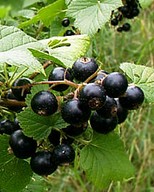 A fruit that is high in
Vitamin C.
A fruit that is high in
Vitamin C.
Origin: Native to Europe and Asia
Grows: Perennial plant that does well in full sun, in rich, well-drained soil. Grows to 5 feet and spreads just as wide. Harvest currants in the summer, and leaves throughout the growing season.
Parts to Use: Berries and Leaves
Uses: Colds, flu and sore throats. Also used for diarrhea and upset stomachs. Can be made into jams, wine and cordial.
1) As Juice: Take small sips throughout the day to treat upset stomachs and diarrhea.
2) As a Syrup: Make into a syrup for colds and flu.
As a Tea: 1-2 teaspoons dried leaves in 1 cup of boiling water for colds, flu and fever. Gargle for mouth ulcers and sore throats.
As a Tincture: Take 1 teaspoon leaf tincture in a little water, 3 times daily to bring down high blood pressure.
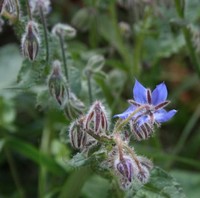 Origin: Native
in Mediterranea Areas and Asia
Origin: Native
in Mediterranea Areas and Asia
Grows: A very easy herb to grow that self-seeds happily. Will grow in most soil types. Harvest the leaves and flowers in the summer.
Parts to Use: Flowers, Leaves, Seeds
Uses: For Stress, skin rashes, eczema, arthritis, IBS, menstrual disorders.
1) As a Tincture: Use 1 teaspoon, 3 times a day for combating stress. Discontinue after 3 weeks use.
2) As Seed Oil: Used for IBS, menstrual disorders, arthritis and eczema.
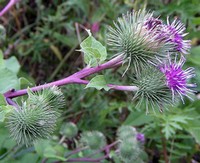 Origin:
Native to Europe and Asia. Found in North America.
Origin:
Native to Europe and Asia. Found in North America.
Grows: In moist, alkaline soil in full sun, or partial shade. A biennial with purple thistle-like flowers growing to 5 feet in height and spreading to 3 feet. Harvest roots in spring and the leaves when the plant is just about to flower in summer.
Parts to Use: Roots and Leaves
Uses: As a blood purifier, diuretic, mild laxative, antibiotic, antiseptic, psoriaisis, acne, boils, eczema, arthritis, prostate problems.
1) As a Poultice: Crush the leaves and apply directly to the skin for problems, cuts and burns. The leaves can also be heated and applied hot to boils and other ailments where drawing out is required.
2) As a Decoction: Chop 1 oz fresh burdock root and dandelion root and simmer in 3 cups of water for 20 minutes. Strain and drink throughout the day to treat acne, psoriasis, eczema, and as a detox.
Use cold directly on the skin for acne, ringworm and athlete's foot.
As a Tincture: Take 2 teaspoons of root tincture 3 times daily for arthritis and kidney stones.
 Grows:
A self-seeding flower that likes full sun and a
well drained soil. Grows to height of nearly 2 feet.
Grows:
A self-seeding flower that likes full sun and a
well drained soil. Grows to height of nearly 2 feet.
Parts to Use: Flowers and Leaves
Uses: 1) Making soothing ointments for insect bites, sunburn, scratches and burns.
Also use for ringworm, eczema, nappy rash, and sore nipples when breast feeding.
2) As a Tea: 1 teaspoon dried petals per 1 cup boiling water and allow to steep for 10 minutes to treat digestive disorders, including colitis. When cool can be used as a douche for vaginal thrush. As a mouth wash for gum disease.
3) As a Tincture: 1 teaspoon, 3 times a day for painful periods and heavy menstrual bleeding.
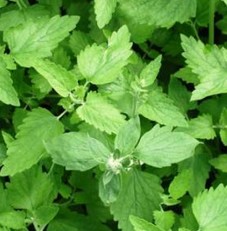 Origin: Native
to Europe
Origin: Native
to Europe
Grows: 3 feet high and 2 feet wide. Grows in moist, well drained soil in full sun. Harvest the aerial parts in the summer, just as the plant comes into flower.
Parts to Use: Flowers, Leaves and Stems
Uses:
1)As A Tea: 2 teaspoons dried leaves to 1 cup of boiling water. Take 3 times a day for colds, flu and stomach upsets. Safe to give to children if they are coming down with a sore throat. Half does and safe to give to babies with colic.
2) As A Tincture: Use a couple of teaspoons neat and rub onto areas affected with arthritis.
 Origin: Europe and Asia
Origin: Europe and Asia
Grows: In moist soil in full sun and if allowed to grow unhindered can grow up to 2 feet in height. It has small smooth leaves, small star-like flowers and small hairs on the stem.
Parts Used: Flowers, leaves and stems
Uses: As a spring tonic as it is full of good vitamins and trace elements. Can be used in salads as well as a tea or tincture.
1) As a Poultice: Crush the leaves, stem and flowers and place directly onto the skin and use as a poultice for bruises, cuts, boils, gout, insect bites, eczema, sunburn or burns.
2) As a Tea: For weightloss, body cleansing, rheumatism and urinary infections. Use 2 teaspoons chopped chickweed in 1 cup of water and use 3 times a week.
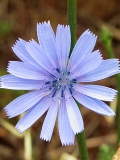 A plant that is often used as a coffee
substitute. The leaves can be
harvested anytime of year, however, the later after spring, the more
you have to boil the leaves and change the water several times to
render the plant bland as it can be quite bitter, otherwise.
A plant that is often used as a coffee
substitute. The leaves can be
harvested anytime of year, however, the later after spring, the more
you have to boil the leaves and change the water several times to
render the plant bland as it can be quite bitter, otherwise.
Origin: Native to the Mediterranean. Introduced to North America, Europe and Australia.
Grows: Pretty cornflower blue flowers on tall stems that can grow up to 5 feet high. Likes an alkaline soil that is moist and can grow in full sun. Lift the roots in the second year in early spring. A plant that will easily self-seed once established.
Parts Used: Roots, Flowers, Leaves
Uses:
1) As a Coffee Substitute:You can make chicory coffee by digging the plants and cutting off the leaves. Peel the roots, slice them in thin strips and roast in a 250° oven for about four hours. Grind the roasted roots and use one teaspoon of ground root for each cup of water. Boil for about three minutes.
2) As a Tea: 2 teaspoons leaves to 1 cup boiling water, 3 times a day to aid digestion. If you use fresh leaves after spring they can be bitter. However, you can still use them by boiling them in water and changing the water as many times as you like until you find them palatable.
3) As a Decoction: Take 2 teaspoons root to 1 cup boiling water, 3 times a day as a liver tonic and to balance good gastrointestinal flora.
* Chicory extract has been known to be a good for treating parasitic worms in sheep and cattle.
Although I am a firm believer in herbal medicine, I am also aware that there are times when you need to seek the advice of an allopathic physician, and so I am not beating a drum here, but showing you that there is definitely help at hand, often in herbs that others might concern weeds, such as the common dandelion, that in fact is one of the most useful little herbs around.
Dandelions have been used to lower blood pressure, helps prevent some types of breast cancer, can help with acne, arthritis, constipation, eczema, and lowering high cholesterol.
So next time you are pulling those dandelions out of your garden cursing their existence, be grateful that they are there and think twice about their use and how your health will benefit from using them, rather than just throwing them away.
How to Prepare Herbal Teas
Making herbal teas can either be made using fresh flowers and leaves or fried flowers and leaves of the various herbs. Herbs are cut during the summer, tied in bunches and then hung upside down to dry so as to encourage the concentration of the healing properties in the flowers and leaves.Drying is best in the shade where air circulation is good, either laid on racks or hung up in bunches.
Once the herbs are dry these can be stripped from the stalks, placed in brown paper bags and used when needed.
How to Prepare Herbal Tinctures
Medical tinctures are made by packing glass jars with the fresh or dried herbs, then covering the plant material with either brandy or vodka, leaving the herbs in a dark cupboard for 6 weeks, shaking the bottle occasionally, straining the herbs through a muslin cloth, and then storing the mixture in a dark cupboard until needed. Doses are given using an eye dropper, mixed with a little water.How to Prepare Herbal Decoctions
Decoctions involve boiling plants - usually the woody or harder parts of plants (berries and seeds, roots, barks) in a covered saucepan for about 20 minutes or longer, until half the amount of water as was originally used, is left behind.Herbal Creams and Lotions
Preparations for
external use include ointments (oil based), creams (water based),
linaments (oily liquid preparations) and poultices (powdered dried
herbs or crushed fresh herbs applied to the skin for medicinal or
cosmetic uses such as facial
masks).
Medicinal Herbs and How to Use Them
Agnus Castus (Vitex Agnus Castus) "Chaste Tree"
 The berries were known as
"Monk's Pepper" as it was used in the food in
monasteries to reduce the libido in monks, although it is said to have
the opposite effect on women.
The berries were known as
"Monk's Pepper" as it was used in the food in
monasteries to reduce the libido in monks, although it is said to have
the opposite effect on women.Origin: Native to the Mediterranean Area Grows: In well-drained soil in full sun. Grows to 15 feet, and spreads from 6-25 feet with pale, lilac flowers in early autumn.
Parts to Use: Harvest the berries when ripe in late autumn.
Uses: Mainly for gynaecological problems; irregular periods, acne and migraines related to the menstrual cycle. Also used for PMS and to regulate the hormones.
As a Tincture: Use 5 drops (1/2 teaspoon) in a little water 3 times a day. This is a powerful herb and should be used with caution. Start with a small dose to start off with. Don't use if you are pregnant.
Agrimony (Agrimonia Eupatoria)
Origin: Europe and Introduced into North America Parts to Use: Above
ground
parts, after flowering in the summer. Harvest
the leaves and flowers and dry for making tea.
Parts to Use: Above
ground
parts, after flowering in the summer. Harvest
the leaves and flowers and dry for making tea.Uses: Excellent wound herb. Used to stop bleeding and to relieve pain. Tightens and tones body tissues.
As a Tincture: Effective against vaginal infections and cystitis, asthma, anxiety and stress, tapeworm, chronic diarrhea, dysentery.
Strip off the fresh flowers and leaves of the plants on a sunny day, pack into a glass jar, cover with brandy or vodka. Tighten lid and place in dark cupboard for 6 weeks, shaking every few days. After 6 weeks strain and label. Use 3-5 drops in a little water 3 times a day. For chronic situations, use 1/2 teaspoon in water, 3 times a day.
As a Tea: It can be used to bathe the eyes for conjunctivitis or as a gargle for sore throats or bad gums. Take 1-2 teaspoons dried leaves and flowers and pour over 1 cup of boiling water. Steep for 15 minutes and then drink up to 3 cups a day.
Aloe Vera (Aloe Vera)
Origin: Tropical Africa Grows:
In
sandy, well drained soil in a sunny place. As an aloe it needs little
water or care.
Grows:
In
sandy, well drained soil in a sunny place. As an aloe it needs little
water or care.Parts to Use: The fleshy leaves and the gel inside. It can be harvested any time during the year.
Uses: Excellent for burns, insect bites, skin ulcers, wounds, nappy rash, eczema, ringworm, shingles and constipation.
Topical: Most of the time aloe vera gel is used directly on the skin. It needs little preparation to get the results. Just break off a little of the leaf, spilt it open and scrap out the soft inside, and place on the skin like a poultice.
As a Tincture: Pulp the leaves in a food processor. Place in jar and cover with brandy or vodka and process in the usual way. Take 1 teaspoon in some water, 3 times a day to treat a sluggish digestion and constipation.
Aloe Vera also makes an excellent chicken food.
Angelica (Angelica Archangelica)
 Picture
courtesy of Teun Spaans
Picture
courtesy of Teun SpaansOrigin: Native Northern Europe
Grows: This is a perennial that grows in moist soil in shady areas. Grows up to 8 feet in height and spreads to 4 feet. Harvest the leaves and stems in early summer, year old roots in autumn, seeds as they ripen.
Parts to Use: Leaves, roots, seeds for the essential oils
Uses: For arthritis, rheumatism, flatulance, poor circulation, bronchitis, coughs, sluggish digestion
As a Tincture:Use 1/4-1/2 teaspoon in a little water 3 times a day.
As a Tea: Take 1 teaspoons dried leaves and pour over 1 cup of boiling water. Steep for 15 minutes and then drink up to 3 cups a day. Use for indigestion.
As a Massage Oil: Extract the oil from the seeds and spread on chest for coughs and bronchial troubles.
As a Decoction: Simmer 1/2 oz of root in 1 pint of water. Use for arthritis and rheumatism, poor circulation, sluggish digestion and to warm up the body.
Caution: Don't use as a tea or a tincture if you are pregnant or if you are a diabetic.
Astragalus (Astragalus Membranaceus) "Milk Vetch"
 Origin:
Native to Asia
Origin:
Native to AsiaGrows: Grows in well-drained soil in full sun. Grows in a bush 3 feet high, 1 foot wide. To harvest, dig up the roots of 4 year old plants in autumn.
Parts to Use: Roots
Uses: For excess sweating, chronic fatigue, boosting the immune system and used with other herbs such as ginseng.
As a Tincture: Use 1/2 teaspoon in some water as a general tonic, to boost the immune system and for chronic fatigue.
Caution: Don't take if you are on blood-thinning tablets.
Bilberry (Vaccinium Myrtillus) "Whortleberry", "Huckleberry"
 Seen as a superfood as it has antioxidant
properties.
Seen as a superfood as it has antioxidant
properties.Origin: Europe and Asia
Grows: Loves very acidic soils that are moist. Likes partial shade, although will tolerate some sun. A small bush that grows 2 feet high and 2 feet wide. Harvest the leaves in spring and the berries in late summer.
Parts to Use: Berries and Leaves. Berries can be made into jams, pies, syrups, wine and liqueurs.
Uses: Excellent for improving eyesight especially if used in combination with ginkgo, including macular degeneration and glaucoma. It strengthens veins and capillaries, so good for those suffering from varicose veins. Regulates high blood sugar and urinary infections. Dried berries can be used for diarrhea. Fresh berries can be used for constipation.
As a Tea: For mouth ulcers, urinary infections, bed wetting, reducing high sugar levels, treating late-onset of diabetes.Use 1 teaspoon of dried leaves to 1 cup of boiling water. Steep for 10 minutes.
Caution: Do not use the leaves in tea for more than 3 weeks at a time.
Birch (Betula Pendula)
 Origin:
Eurasia and the Sweet Birch native to eastern North America.
Origin:
Eurasia and the Sweet Birch native to eastern North America.Grows: Like moist, damp, forested areas. Harvest the sap in the spring, before the buds and leaves appear.
Parts to Use: Bark, leaves and sap
Uses:
1) As a Sap: Birch sap is used for kidney stones, skin conditions and rheumatism. Drink in spring as a tonic and for a good detox. Tap the tree by drilling a small hole into the trunk with a tube leading into a bottle tied to the tree. Collect the sap for no longer than a week and plug the hole afterwards.
2) As a Tea: Using the spring buds and leaves for gout, urinary infections, cystitis, water retention. When cold it can be used directly on skin disorders and eczema. Leaves can be used fresh or dry. Use 5 leaves per cup of boiling water.
3) As an Oil: Steep birch leaves in olive oil and use as a massage oil for cellulite. Birch oil is used in commercial cellulite products.
Blackberry (Rubus Fruticosus) "Brambles"
 Origin: Europe
but also found in Australia, New Zealand and North America
Origin: Europe
but also found in Australia, New Zealand and North AmericaGrows: Wild in hedges in the countryside. Harvest the leaves in summer and the berries when ripe.
Parts to Use: Berries and Leaves.
Uses: 1) The berries are used extensively in country wines, jams, jellies, pies and syrups.
2) As a Poultice: Crushed blackberry leaves can be used for boils and small cuts and scratches on the skin. Ideal when you go blackberry picking!
3) As a Tea: The leaves are picked when they are young shoots in spring and used fresh in tea as a tonic.
Dried leaves and unripe fruit can also be used for treating diarrhea when made into a tea, and can also be used to treat mouth ulcers and gum disorders.
Use blackberry leaves for sore throats, colds and treating anemia.
Use 1 teaspoon dried leaves to 1 cup boiling water.
When cool, you can use blackberry tea as a skin lotion.
Blackcurrant (Ribes Nigrum)
 A fruit that is high in
Vitamin C.
A fruit that is high in
Vitamin C.Origin: Native to Europe and Asia
Grows: Perennial plant that does well in full sun, in rich, well-drained soil. Grows to 5 feet and spreads just as wide. Harvest currants in the summer, and leaves throughout the growing season.
Parts to Use: Berries and Leaves
Uses: Colds, flu and sore throats. Also used for diarrhea and upset stomachs. Can be made into jams, wine and cordial.
1) As Juice: Take small sips throughout the day to treat upset stomachs and diarrhea.
2) As a Syrup: Make into a syrup for colds and flu.
As a Tea: 1-2 teaspoons dried leaves in 1 cup of boiling water for colds, flu and fever. Gargle for mouth ulcers and sore throats.
As a Tincture: Take 1 teaspoon leaf tincture in a little water, 3 times daily to bring down high blood pressure.
Borage (Borago Officinalis)
 Origin: Native
in Mediterranea Areas and Asia
Origin: Native
in Mediterranea Areas and AsiaGrows: A very easy herb to grow that self-seeds happily. Will grow in most soil types. Harvest the leaves and flowers in the summer.
Parts to Use: Flowers, Leaves, Seeds
Uses: For Stress, skin rashes, eczema, arthritis, IBS, menstrual disorders.
1) As a Tincture: Use 1 teaspoon, 3 times a day for combating stress. Discontinue after 3 weeks use.
2) As Seed Oil: Used for IBS, menstrual disorders, arthritis and eczema.
Burdock (Arctium Lappa) "Greater Burdock"
Burdock is a powerful blood purifier, and detoxing herb, especially when used together with dandelion. Origin:
Native to Europe and Asia. Found in North America.
Origin:
Native to Europe and Asia. Found in North America.Grows: In moist, alkaline soil in full sun, or partial shade. A biennial with purple thistle-like flowers growing to 5 feet in height and spreading to 3 feet. Harvest roots in spring and the leaves when the plant is just about to flower in summer.
Parts to Use: Roots and Leaves
Uses: As a blood purifier, diuretic, mild laxative, antibiotic, antiseptic, psoriaisis, acne, boils, eczema, arthritis, prostate problems.
1) As a Poultice: Crush the leaves and apply directly to the skin for problems, cuts and burns. The leaves can also be heated and applied hot to boils and other ailments where drawing out is required.
2) As a Decoction: Chop 1 oz fresh burdock root and dandelion root and simmer in 3 cups of water for 20 minutes. Strain and drink throughout the day to treat acne, psoriasis, eczema, and as a detox.
Use cold directly on the skin for acne, ringworm and athlete's foot.
As a Tincture: Take 2 teaspoons of root tincture 3 times daily for arthritis and kidney stones.
Calendula (Calendula Officinalis) "Pot Marigold"
Origin: Europe Grows:
A self-seeding flower that likes full sun and a
well drained soil. Grows to height of nearly 2 feet.
Grows:
A self-seeding flower that likes full sun and a
well drained soil. Grows to height of nearly 2 feet.Parts to Use: Flowers and Leaves
Uses: 1) Making soothing ointments for insect bites, sunburn, scratches and burns.
Also use for ringworm, eczema, nappy rash, and sore nipples when breast feeding.
2) As a Tea: 1 teaspoon dried petals per 1 cup boiling water and allow to steep for 10 minutes to treat digestive disorders, including colitis. When cool can be used as a douche for vaginal thrush. As a mouth wash for gum disease.
3) As a Tincture: 1 teaspoon, 3 times a day for painful periods and heavy menstrual bleeding.
Catnip (Nepeta Cataria)
Catnip is not just a good medicinal herb, but also loved by cats. Origin: Native
to Europe
Origin: Native
to EuropeGrows: 3 feet high and 2 feet wide. Grows in moist, well drained soil in full sun. Harvest the aerial parts in the summer, just as the plant comes into flower.
Parts to Use: Flowers, Leaves and Stems
Uses:
1)As A Tea: 2 teaspoons dried leaves to 1 cup of boiling water. Take 3 times a day for colds, flu and stomach upsets. Safe to give to children if they are coming down with a sore throat. Half does and safe to give to babies with colic.
2) As A Tincture: Use a couple of teaspoons neat and rub onto areas affected with arthritis.
Chickweed (Stellaria Media)
Chickweed is not just good for feeding chickens. It is a herb that is good for weightloss a well as cleansing the system, treating wounds and skin problems. Origin: Europe and Asia
Origin: Europe and AsiaGrows: In moist soil in full sun and if allowed to grow unhindered can grow up to 2 feet in height. It has small smooth leaves, small star-like flowers and small hairs on the stem.
Parts Used: Flowers, leaves and stems
Uses: As a spring tonic as it is full of good vitamins and trace elements. Can be used in salads as well as a tea or tincture.
1) As a Poultice: Crush the leaves, stem and flowers and place directly onto the skin and use as a poultice for bruises, cuts, boils, gout, insect bites, eczema, sunburn or burns.
2) As a Tea: For weightloss, body cleansing, rheumatism and urinary infections. Use 2 teaspoons chopped chickweed in 1 cup of water and use 3 times a week.
Chicory (Cichorium Intybus)
 A plant that is often used as a coffee
substitute. The leaves can be
harvested anytime of year, however, the later after spring, the more
you have to boil the leaves and change the water several times to
render the plant bland as it can be quite bitter, otherwise.
A plant that is often used as a coffee
substitute. The leaves can be
harvested anytime of year, however, the later after spring, the more
you have to boil the leaves and change the water several times to
render the plant bland as it can be quite bitter, otherwise.Origin: Native to the Mediterranean. Introduced to North America, Europe and Australia.
Grows: Pretty cornflower blue flowers on tall stems that can grow up to 5 feet high. Likes an alkaline soil that is moist and can grow in full sun. Lift the roots in the second year in early spring. A plant that will easily self-seed once established.
Parts Used: Roots, Flowers, Leaves
Uses:
1) As a Coffee Substitute:You can make chicory coffee by digging the plants and cutting off the leaves. Peel the roots, slice them in thin strips and roast in a 250° oven for about four hours. Grind the roasted roots and use one teaspoon of ground root for each cup of water. Boil for about three minutes.
2) As a Tea: 2 teaspoons leaves to 1 cup boiling water, 3 times a day to aid digestion. If you use fresh leaves after spring they can be bitter. However, you can still use them by boiling them in water and changing the water as many times as you like until you find them palatable.
3) As a Decoction: Take 2 teaspoons root to 1 cup boiling water, 3 times a day as a liver tonic and to balance good gastrointestinal flora.
* Chicory extract has been known to be a good for treating parasitic worms in sheep and cattle.
More to follow...
More
Herbal
Resources for You:
Benefits
of DandelionStinging Nettles
How to Grow Herbs
Growing Herbs Indoor
Growing Herbs as Companion Plants
Herbal Tea Recipes
Catmint
And if you are looking to plant your own herbs and would like some growing kits, visit our Online Country Store for more details. You will also find health products and herbs to buy through our Naturally Organic section.

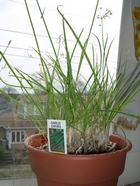
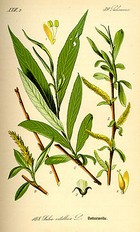
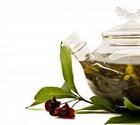

New! Comments
Do you have something of value to add? Leave me a comment in the box below.